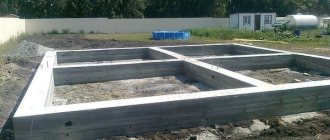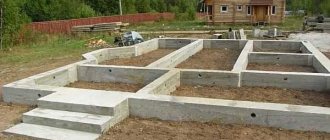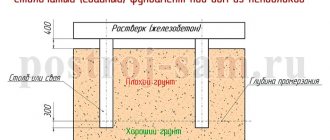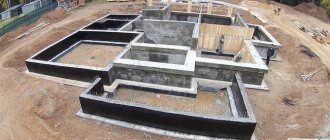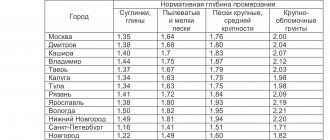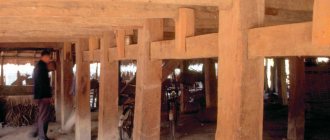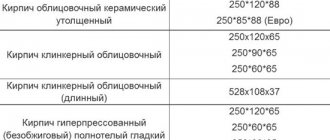In order for the foundation for the building to withstand the load that the box of the house will exert, it is necessary to perform some calculations, as well as obtain data on the condition of the soil in the area where construction is planned. In addition to everything, you need to find out what the total amount of materials consumed is. If you calculate the strip foundation for a brick house, you can preliminarily estimate the cost of future construction and, if necessary, adjust the design of the house.
In order for the foundation for the building to withstand the load that the box of the house will exert, it is necessary to perform some calculations, as well as obtain data on the condition of the soil in the area where construction is planned. In addition to everything, you need to find out what the total amount of materials consumed is. If you calculate the strip foundation for a brick house, you can preliminarily estimate the cost of future construction and, if necessary, adjust the design of the house.
How to calculate the depth and width of the base for construction?
In no case should this parameter be taken by eye, since the reliability of the house depends on the accuracy of the calculations performed.
Such calculations are especially important for a structure that places a significant load on the soil, for example, a two-story house. If an object is planned even higher or using particularly heavy elements (slab flooring), then the strength of the foundation of such a house will play the most important role. The main factors that influence the calculations are:
- building load; soil freezing level; groundwater level; soil density.
For heavy buildings (several floors), the base depth is assumed to be equal to the depth of soil freezing. In some cases it is even recommended to exceed this value by 300 mm. In addition, the foundation will rise above the zero level to a height also equal to 300 mm.
As a result, the total depth of the foundation for construction can be 1800-2000 mm. The range of values depends on the level of soil freezing in a given area. For example, in St. Petersburg this depth is 1,200 mm.
Lighter buildings, for example, a bathhouse or a small cottage, are often built on a foundation that lies at a depth of only 500 mm. As you can see, this parameter requires an objective assessment of several factors, and it is impossible to be guided by average statistical data.
Calculation of a strip reinforced concrete foundation for a brick house also includes determining its width. This parameter is also taken into account the type of material that is planned to be used when constructing the box of the house. Very often the width of the foundation is 400 mm, but for lighter buildings 300 mm may be sufficient.
Leveling the foundation with brickwork
The load-bearing walls of the building rest on the foundation. The secret to the stability of the structure depends on the evenness of each of its four surfaces. To level the bottom plane of the foundation you will need the following tools :
- shovel;
- construction plumb line;
- roulette;
- hammer;
- container for cement mortar;
- Master OK.
Creating a perfectly flat bottom plane of the foundation masonry at the bottom of the trench begins with the installation of a sand cushion. The lower plane is not visible, but its unevenness can lead to problems in the operation of the building. It will not be possible to level the uneven lower plane later; it is necessary to immediately make it perfectly level.
High-quality formwork allows you to obtain smooth internal and external surfaces. However, there are times when the foundation is not level, despite following all the rules for constructing formwork.
How to level a brick foundation? Methods for leveling the base surface
- Installing new formwork and pouring concrete solution allows you to cope with significant surface unevenness.
- Brick lining is important for eliminating minor defects in the base.
- Covered with a chain-link mesh, fixed with a thick layer of plaster.
- Covering with a layer of additional thermal insulation (expanded polystyrene, mineral wool) hides small irregularities.
Methods for leveling the upper plane of the foundation
More often than not, it is the upper plane of the base that suffers from unevenness. Since walls are built from it, perfect evenness is required. To obtain a flat surface, constantly use a water level . The hydraulic level is used to check, first of all, the corners, then the perimeter of the base. It should be remembered that only a water level without bubbles gives correct measurements. When finishing the laying, you should use a liquid cement mortar, which will level the surface over the entire area.
A small difference, for example, 2 cm, relative to zero can be corrected with brickwork if you change the thickness of the horizontal seam. SNiP sets standards for the thickness of a horizontal seam - the maximum value should not exceed 12 mm, with a tolerance of +3, -2 mm. A deviation of up to 15 mm from the horizontal per 10 m of masonry is allowed. This deviation is eliminated by laying the next row of bricks.
Calculation of the nominal area of the foundation
Having decided on the depth and width of the base for construction, it is also necessary to obtain the nominal value of the area. This must be done in order to assess the ability of the foundation to evenly withstand the loads transmitted by the structure. So, the nominal area of the base is calculated using the formula:
S > k(n)*F/K(c)*R,
where k(n) is the reliability coefficient, which is 1.2, which means that the area reserve will be equal to 20%;
F is the total load transmitted by the building to the ground, this will include both the load from the structure and from its base, in a word, any stress created by external factors is taken into account;
K(c) is the operating conditions coefficient, its value can be taken equal to 1 (for plastic clay and a very rigid structure) or equal to 1.4 (for lightweight construction and coarse sand);
R is the calculated soil resistance, this value is taken from the table.
Based on these parameters, you can select the value of soil resistance according to its type.
To do this, it is also necessary to have data on how dry/wet the soil is and what its porosity coefficient is. Having received the soil resistance value, all that remains is to find out what loads the foundation for the building will take on. Accordingly, calculating the foundation for a brick house implies the need to sum up all possible stresses, which are given in the table.
Building design
Scheme for calculating the foundation for a brick building
Any foundation begins to be erected according to the preliminary design of the future building. It already takes into account the building materials, height, dimensions and dimensions of the structure, as well as the type of roof, so calculating the weight of the building is not difficult. This is easy to do if the house is made of solid brick, since all the data is in the regulatory documents.
How to determine material consumption
After the value of the depth and width of the foundation for construction has been obtained, a house project is drawn up, which includes a foundation construction plan.
Then you can begin to calculate the total amount of materials used in the construction of the foundation. The first step is to obtain the value of the total length of the foundation. Not only its perimeter is taken into account, but also the lengths of all internal walls under which it is planned to lay the foundation.
To obtain the volume of concrete mixture, it is necessary to multiply the total length of the foundation by its depth and width. As a result, we obtain the amount of material required to lay a monolithic foundation.
You can calculate its mass quite simply, for which you just need to multiply the volume of concrete by its density, which is 500-2500 kg/m3. To calculate the amount of reinforcement, you need to multiply the total length of the foundation by 4, which is how many horizontal rods are usually used. To the obtained value you need to add another 30%, which will be spent on laying the crossbars, which act only as fastenings.
As you can see, the total number of necessary calculations is quite small and all the required parameters can be calculated in a short period of time, without delaying the construction of the house. The main thing here is to be careful, since too large an error in the calculations is fraught with low strength of the foundation
We have decided on the type of foundation; those who have read previous articles remember that in all respects, a strip buried foundation was the ideal option for our house. Today we will talk about its depth, thickness and other equally important parameters.
Since the foundation is a strip foundation, the main criterion in choosing the depth of foundation is the depth of soil freezing in the region where the house is being built, as well as the groundwater level (GWL) and the type of soil.
In our region, the depth of soil freezing is slightly more than 1 meter, and therefore, it was decided to deepen the foundation by 1.10 m.
But things don't always go so smoothly. Sometimes the groundwater level is located high, sometimes the soil leaves much to be desired, and very often it happens that the depth of soil freezing in the region is high, and therefore the cost of a strip foundation will increase significantly.
In order to correctly calculate the depth of the strip foundation, I suggest that you read the relevant article on this site. It describes in detail under what conditions and at what depth the foundation is laid, as well as ways to reduce this depth and, accordingly, costs.
Well, we’ve decided on the laying depth, now let’s find out how to determine the thickness (width) of the foundation.
How to lay a brick on a foundation
Working tools should be prepared in advance :
- trowel (or trowel) for laying out the mortar, removing excess mortar, leveling;
- a mason's hammer for splitting bricks into pieces of the required size;
- a plumb line checks the verticality of the masonry;
- the cord helps to lay out rows in straight lines and maintain one height indicator;
- the ordering marks the rows according to the thickness of the seam and brick;
- the wood rule checks the quality of the external surface;
- shovel;
- container for stirring the solution (or concrete mixer).
First, we lay roofing felt to isolate the cleaned foundation from moisture. There are two ways to go.
The first way is to completely lay out the first row, and then the corners. In this case, the corner should always be several bricks higher than the walls. We check the straightness of the corners, the verticality of the masonry with a level, a square, and a plumb line.
The second method is to initially draw out all the corners, after which the walls are laid. Checking the corners occurs using the same tools. Unevenness should be corrected by tapping the incorrectly placed bricks with a hammer. The stage ends with tying a cord for guidance in the corners. Now you can begin the main part of the work.
Some recommendations for the accuracy of laying bricks on the foundation
The masonry technology is simple:
- lay out and level the width of the mortar to one and a half centimeters with a trowel;
- lay the brick, lightly pressing it down to evenly distribute the binder mixture;
- Gently tapping with a hammer, level the stone, following the line marked with the cord;
- collect excess mortar with a trowel and fill the vertical seam between two bricks.
Some experienced builders pre-apply a small amount of binder mixture to the side edge of the brick to bond it to the adjacent one.
And here is an article about a columnar grillage foundation.
Foundation thickness for a brick house
If we talk about calculating the thickness (width) of the foundation strip for a brick house, then it comes down to calculating the required support area for the house, which takes into account everything from the weight of the house itself to all the parameters of the soil on the construction site. Also, the thickness of the walls plays an important role in determining the width of the foundation.
It would be logical to assume that the wider the monolithic tape, the stronger it will be and the more support it will have on the ground, but by doing so we significantly increase the cost of constructing the foundation as a whole. Therefore, the thickness should be optimal. In other words, the width of the foundation must be chosen in such a way that there is sufficient strength and support on the ground, and it is also necessary to minimize the cost of concrete, which is the most expensive material for a strip foundation.
I already wrote about how to calculate the foundation for a house in one of the previous articles, so in order not to repeat myself, if you are interested, you can take a look. In this calculation, you will learn how to determine the load on the foundation, what its area of support on the ground should be, and much more.
Well, if the soil on your site is not very bad, and the area is not swampy, then, in principle, the width of the foundation strip can be selected from the thickness of your external load-bearing walls. So that later there are no problems with large overhangs of the material from which the walls will be constructed.
What the base of the house will be built from also plays a huge role. If, for example, it is made of brick, then the thickness of the foundation, for practicality, should be a multiple of the width of the brick, i.e.
38 cm, 51 cm, etc. Well, as a rule, for good measure, the width is chosen as a multiple of 10 cm, i.e.
i.e. 40cm, 50cm, etc.
In addition, we can say that with a foundation width of 40 cm and a plinth width of 38 cm, it will be easier to correct foundation marking errors and build a plinth with greater geometric accuracy.
The width of our foundation will be 40 cm, this is a kind of “standard” for our area, and most strip foundations are made in exactly the same way.
Despite the fact that the walls of our house will be about 50 cm, in order to save money, we can leave the thickness of the foundation for our brick house at 40 cm; this will be enough for support and reliability. The base will also be about 40 cm, and on top of the base we will immediately pour a concrete floor with a solid monolithic slab, which will help compensate for the difference in the width of the foundation and the thickness of the walls.
We calculate the specific pressure on the ground.
We check the selected dimensions of our foundation for operability. The check is carried out using a simplified method to ensure that the foundation meets the requirements of DBN V.2.1.-10-2009 “Foundations and foundations of structures”. (Appendix E). (For more details, see the article Calculation of strip foundations).
The purpose of the calculation is to determine the ratio of the specific pressure on the soil under the base of the foundation from the weight of the house - R t/m2 and the calculated soil resistance - R t/m2. The calculated soil resistance characterizes its ability to absorb the load from a building without settlement. The value of P is determined by calculation, and R is regulated by DBN V.2.1.-10-2009.
The main requirement for reliable operation of the foundation is compliance with the conditions under which the P value must be less than the R value.
We determine the specific pressure on the soil under the base of the foundation P t/m2.
To do this, divide the total weight of the house with loads of 238.0 tons by the area of the base of the foundation 21.4 m2, we get P = 11.12 t/m2.
According to Table E.2 DBN, we find that R for fine sands is 20.0 t/m2. When determining R, since geological studies of the soil have not been carried out, we select the minimum indicator of this value from the table (indicators of porosity, humidity and water saturation of the soil).
As we see, R is greater than P, which corresponds to the main condition for reliable operation of the foundation.
To create a safety margin for the foundation that covers inaccuracies in the selection of initial data, it is necessary that the value of R be 15-20% greater than P. For us, with a 20% margin, it is enough to fulfill the condition - the value of P should be no more than 16.0 t /m2 (control value).
How to calculate reinforcement for a house foundation
How to choose the right reinforcement diameter, reinforcement pattern, as well as its quantity, I have already talked about in the article about calculating reinforcement for strip foundations.
As for the reinforcement for the foundation of our house, everything is simple here - the reinforcement will be made with reinforcement with a diameter of d12 and d8.
The reinforcement scheme will consist of 4 horizontal rods along the entire perimeter of the house, with vertical and transverse inserts forming a rectangle approximately every 1.0 - 1.5 m.
The horizontal reinforcement bars, which will bear the maximum load on fracture and rupture, will have a diameter of 12 mm and there will be 4 of them, two at the top and two at the bottom. The vertical and transverse reinforcement will be 8 mm, so we will save a little. And so, we calculated the depth of the foundation and the thickness of the strip foundation for our brick house, and also decided on the reinforcement. In the next article, I will finally move on to the construction itself and tell you how the foundation was poured. Even if you are building your house yourself, you must first draw up at least a semblance of a construction project. When designing a future house, you must first perform basic calculations, including calculations foundation.
You need to find out what load will act on the future foundation and the soil underneath it, and clarify the size of the foundation’s supporting area. The calculation of the foundation will be simplified, since in this case an exact calculation is not needed. This example considers the calculation of the foundation for a brick house. We will assume that the load from the future house will be evenly distributed over the entire supporting area.
Calculating the load on the foundation - house weight calculator.
Calculating the load on the foundation from the future house, along with determining the properties of the soil at the building site, are two primary tasks that must be performed when designing any foundation.
An approximate assessment of the characteristics of load-bearing soils on our own was discussed in the article “Determining the properties of soils on a building site.” And here is a calculator with which you can determine the total weight of the house being built. The obtained result is used to calculate the parameters of the selected type of foundation. A description of the structure and operation of the calculator is given directly below.
How to calculate the weight of a house
Approximately calculate the weight of the house. Use the average values of the unit weights of the house structures:
The specific gravity of brick walls with a thickness of 0.15 m is 270 kg/m2, (see Weight of 1 m3 of brickwork) Specific gravity of 1 m2 of floors:
Wooden attic beams, insulation, dense
up to 200 kg/m3 – 100 kg/m2. Basement on wood. beams, insulation, dense up to 200 kg/m3 – 150 kg/m2.
The specific weight of 1 m2 of steel roofing is 30 kg/m2.
This example house has the following structures:
- Walls - brick. Ceilings - wooden. Roof - sheet steel. Strip foundation - reinforced concrete (i.e. concrete in which reinforcement is embedded).
Let's say that you intend to build a house on 2 floors, with a plan of 5 x 5 m.
Each floor has a height of 2.5 m. One wall is internal. Then the length of the external walls of two floors will be 5 x 4 x 2 floors.
= 40 m, plus an internal wall 5 x 2 floors = 10, total 50 m. Area of all walls: S art. = 50 x 2.5 m = 125 m2.
The floor area of the basement, as well as the attic, will be 5 x 5 = 25 m2. The roof overhangs 50 cm on each side. The roof area is taken as 6 x 6 = 36 m2.
We calculate the load of structures on the foundation (multiply the specific weight by the area of each structure). To the constant load we add the weight of snow (100 kg/m2). The roof area of the house is 36 m2, so the snow load will be 36 m2 x 100 = 3600 kg.
Brick walls, 33750 kg Basement
cross., 3750 kgChart. overlap, 2500 kgWeight steel. roofs, 1080 kg Snow, 3600 kg House total, 44680 kg
Description of the house.
One-story brick house.
The composition of the premises is shown in the drawing. Net area - 84.1 m2. Living area - 72.6 m2. Roof area - 175.8 m2. Overall dimensions of the house: 8.9 x 11.9 x 5.55 m. General view of the house
Layout
Section of a house
House foundation diagram 8.9 m x 11.9 m.
The construction of the house is supposed to be on fine sandy soil. Objective data: freezing depth up to 1.4 m; the distance from the planning mark to the groundwater level during the period of soil freezing exceeds the calculated freezing depth by more than 2 m. Construction site - Moscow region.
Taking into account objective data, we assume a foundation depth of 1 m and a width of 0.4 m (preliminary data). The length of the foundation according to the accepted scheme is 53.5 m. The total area of the base of the foundation: length 53.5 m x width 0.4 m = 21.4 m2.
Structural elements and materials used:
- foundation – strip, monolithic reinforced concrete;
- base – solid brick;
- external walls - solid bricks (2 bricks) with insulation, internal walls - hollow bricks (0.5 bricks);
- The roof structure is wooden, gable. The tilt angle is 30 degrees. Wood volume of the roof truss structure: 13.9 m3;
- Windows - wooden, double. External doors are metal, internal doors are wooden;
- roof - ceramic tiles;
- facade - thin-layer plaster;
- the heating boiler is installed on a separate foundation;
- floor – wooden beam, floorboard;
- ceiling - floor slabs made of aerated concrete;
- basement floor - aerated concrete floor slabs;
- insulation, waterproofing.
How to calculate the weight of the foundation and its supporting area
To determine the load on the ground, you need to add the weight of the foundation to the weight of your house.
If you do not insist on a columnar foundation with a grillage, it is better to lay a strip foundation under a brick house at a depth below the frost line. Let's take it 1.7 m and add another 0.3 m to the base. The total height of the foundation will be 2 m.
The length of the tape will be 25 m (20 m perimeter + 5 m of foundation under the inner wall). With a thickness of 0.3 m, calculate the volume of the foundation: 25 x 0.3 x 2 = 15 m3. Reinforced concrete has a density of 2500 kg/m3.
The foundation weighs 37,500 kg. Such a foundation will have a supporting area of 25 x 0.3 m = 7.5 m2. Total weight: house plus foundation is 82180 kg.
To calculate the entire load on the ground, you need to divide the total weight by the supporting area of the foundation.
For any dry soil, the bearing capacity is taken to be no less than 2 kg/cm2.
- Foundation weight, kg – 37500. House weight, kg – 44680. Total weight, kg – 82180. Area, cm2 – 75000. Ground load, kg/cm2 – 1.1.
We have a load from a brick house on a strip foundation of 1.1 - there is a reserve. If the load is too heavy, its supporting area must be increased.
So, you have calculated the foundation for a brick house. When you choose the type of foundation for your house, taking into account its characteristics, you can calculate the consumption of concrete and calculate the reinforcement for it (see Calculation of reinforcement for a strip foundation).
Bricks and foundation
Inexperienced masons are most often puzzled by this question. It is very difficult to adjust the foundation to the bricks so that they remain intact. It's much easier to do the opposite. After the dimensions of the foundation are determined, you need to measure the length of each brick and the approximate width of the seam. You need to build on this data. If you don’t want to cut the brick, you can move it beyond the edge by 3 or 5 cm.
New publications are published daily on our channel in Yandex.Zen
Go to Yandex.Zen.
Determining the depth of the base
Before building a foundation for a brick house, the type of soil is determined by drilling. The type of soil affects the load-bearing capacity of the building. Natural soil has the following characteristics:
1 kgf per square. cm – wet dusty sand; 2-2.5 kgf per square. cm - fine, medium fraction of sand; 3 - 3.5 kgf per square.
cm – gravelly and coarse sand; 4-5 kgf per square. cm - gravel; 1-3 kgf per square. cm – clayey and hard soil.
Using test drilling, the type of soil under the main cushion is determined.
The trench under the house should not exceed one meter if the soil on the site is homogeneous and has little moisture. Experts recommend digging a foundation depth for a brick house 30 centimeters below the soil freezing level. This will avoid deformation and distortion of the concrete structure.
If the monolithic foundation is laid above the soil freezing index, the soil will swell.
When determining the depth of the foundation strip, the freezing index of the ground must be taken into account. Its meaning varies in different areas. In the south, the soil freezing parameter is no more than 1 meter, and in the north the soil can freeze more than 2 m.
Calculation of the foundation for a brick house: calculator.
Foundation calculation calculator.
The construction of any house begins with determining the type and size of the foundation. The integrity and durability of the entire building depends on the strength of the foundation. A brick residential building is usually built on a monolithic strip foundation. With this method of laying, design and installation work is carried out independently.
To calculate the foundation of a brick house. it is necessary to determine the permanent and temporary loads that act on its structure and the surface of the earth. The lower elevation of the strip foundation depends on the density of the soil, its composition, freezing depth and groundwater level in the area.
Calculation of the mass of the structure
Calculation of the foundation for a brick house begins with determining the weight of each wall. The weight of all roofing materials and rafters is also taken into account. A small margin is added to the result of the total weight of the structure.
To determine the supporting area of a building, it is necessary to determine the degree of pressure on it from the structure.
The mass of the structure is divided by the area. The value must be converted to N/m2. When calculating a monolithic foundation for a brick house, the mass of the structure is added to the weight of the foundation itself and divided by S of the house.
This makes it possible to identify the pressure of the entire structure on the soil. This indicator must be within acceptable limits. You can use a calculator for all calculations (nowadays it is quite common to use an online calculator, which can be found on the Internet).
Then calculations are made of the materials required for construction. The choice of building material depends on financial capabilities. Reinforced concrete slabs, stone, brick, and reinforced concrete are used in construction.
For example, foundation piles for a brick house can be built from brick or concrete. The erected foundation, if the calculations are carried out correctly, is resistant to temperature changes and is not susceptible to cracks. The construction of any structure always begins with the calculation of the foundation.
When identifying the mass of the rafter system, it is necessary to take into account the properties of the coating and the structure itself. The approximate weight of finishing materials is 20 tons. This includes the weight of plaster, insulation, doors, windows, screed.
Monolithic floors in houses weigh 500 kg per square meter. meter. It is also important to calculate the weight of roofing materials - tiles, slate, metal.
It is important to calculate the total mass of the brick house and its pressure on the ground.
For example: with a brick wall weight of 248,724 kg and a floor weight of 96,000 kg, a roof weight of 7,150 kg and natural influences of 14,300 kg, the total mass will be 366,174 kg. This value indicates the exact impact that the house will have on the soil. Next, the S support is calculated.
In this case, the minimum stability of the soil is taken - 20,000 kg per square meter. With a weight of a monolithic base of 2400 kg per cubic meter, the total mass of the entire building with the foundation will be 366174 + 110300 = 481174 kg. Using this calculation of the required foundation for a brick house, you can be sure that the foundation of the entire structure will withstand any environmental loads.
When making calculations, be sure to pay attention to the density of the floor material. The volume of the strip foundation of a brick house helps determine the total weight of the floors. To calculate the S base of the house, the length of the inner wall is multiplied by the perimeter of the house.
How to calculate the load on the ground?
Any foundation of a brick house exerts a certain load on the ground. Therefore, it is very important to identify the ratio of the total weight of the building to the supporting S of the foundation. Its minimum value should be 2 kgf per square centimeter for normal soil. During construction, it is necessary to calculate the optimal strength of the future foundation. To do this, the total weight of the building is divided by the total area, volume of the base, and its mass. For example, with S 97,500 square centimeters, a foundation volume of 17.55 cubic meters, a foundation weight of 43,875 kg and a building mass of 140,886 kg, the load on the soil will be 1.45 kg per square centimeter. It is necessary to divide 140886 kg by 97500 cm2. It is important to always add 20% to load calculations.
The strip or monolithic base of a brick house requires precise construction calculations. There are certain standards that must be followed when laying the foundation. The lower value of the foundation of the house depends on the composition of the soil, its density and the presence of a nearby water flow. If the house has two floors, then the total length of the internal floors, as well as the loads of the frame, roofing and finishing materials are taken into account. Be sure to calculate the mass of external floors to find out the required area. At the same time, the area of the support zone of the house is calculated. The weight of the brickwork also affects the soil.
The reliability of a house depends on the foundation. Correct calculations of a monolithic or prefabricated foundation will allow the construction of a brick house to be completed with the highest quality possible. Such a building will last for many years and retain its high technical characteristics.
How to calculate permanent loads
The loads imposed by insulating materials, engineering systems, building structures, plumbing, furniture, and people are considered permanent.
It is important to calculate their impact. The stress from the walls has a direct impact on the foundation of the building itself. To calculate this indicator, you need to determine the total area of the walls and multiply it by the weight of the wall (with a thickness of 15 cm).
Also, the calculation of loads reveals the mass of basement and attic slabs.
Their S is multiplied by the weight of reinforced concrete. You can calculate the payload from the internal maintenance of the house if you multiply the entire area of the building by the maximum load parameter of 180 kg per square meter. meter.
Choosing a brick for the foundation
In the construction business, they work with two types of bricks - silicate and ceramic. What kind of foundation brick can I use? Silicate ones are highly hygroscopic and therefore their use is unacceptable in the construction of foundations.
The foundation brick meets the following criteria:
When you hit it with a hammer, it should ring. It shouldn't crumble. If there are melts or cracks on its surface, it is better to put it aside. The brick must withstand 25 freezing cycles.
How to calculate seasonal loads
They take as much snow as possible, which is typical for the region. Then you need to determine the number of seasonal loads. To do this, S of the roof coverings (on the slopes) is multiplied by the possible weight of the snow masses.
For example, S = 81 m2, and the amount of snow is 100 kg per square meter. meter. To calculate the value correctly, you need to use a certain coefficient for pitched roofs - 0.86.
That is, you need to calculate the required value like this: 81x100x0.86. The result will be 6966 kg. This will be an indicator of seasonal loads.
Construction of a brick house is a complex process. It requires the accuracy of all quantities and parameters. Otherwise, the brickwork may become deformed and crack.
Any construction work requires correct values, checks and calculations. When calculating seasonal load, it is especially important to take into account the topography of the soil, the type of soil, and the proximity of groundwater. An important role is played by the climatic features of the region in which construction is carried out.
Determining the location of groundwater
For this study, a well 3 meters deep is being formed on the territory of the future building. If there is already a deep hole, then you can use it to determine the level. It is best to study groundwater in spring or autumn, when the level is highest.
Also, with the help of simple manipulations, you can find out the composition of the soil. To do this, you first need to remove the top fertile soil; it is under it that the soil will be hidden, on which the foundation will put pressure.
